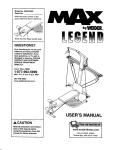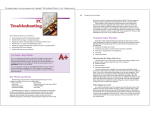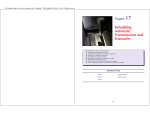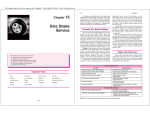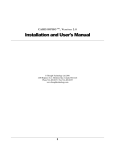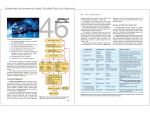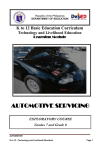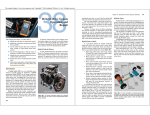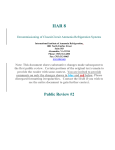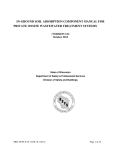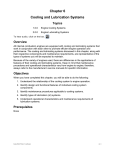Download Chapter 23 - Goodheart
Transcript
This sample chapter is for review purposes only. Copyright © The Goodheart-Willcox Co., Inc. All rights reserved. 454 Auto Diagnosis, Service, and Repair 23 Combustion chamber gases 4500°F (2484°C) Piston crown center 550-575°F (288-302°C) Cooling System Service After studying this chapter, you will be able to: • Explain the role of antifreeze in an engine cooling system. • Properly clean a cooling system. • Detect leaks in a cooling system. • Test a radiator pressure cap. • List the safety rules dealing with cooling systems. • Inspect and replace cooling system hoses. • Inspect, replace, and adjust drive belts. • Test and replace a thermostat. • Inspect, repair, and replace a coolant pump. Technical Terms Depressurized Overheated Overheating protection Antifreeze Ethylene glycol Propylene glycol Long-life coolant Organic acid technology Hard water Electrolysis Hydrometer Refractometer Test strips Alkalinity Ph level Bleeder valve Reverse fill Cooling system cleaner Neutralizer Reverse flushing Pressure tester Pressure cap Electrochemical degradation (ECD) Belt tension Electric fan assembly Thermoswitch Fluid clutch fan Thermostat Coolant pump Impeller Freeze plugs Air-cooled engines This chapter will cover the service requirements of modern cooling systems, including diagnosis, coolant replacement, system flushing, and repair operations. Although most of the information in this chapter relates to liquid-cooled systems, air-cooled systems are also discussed. Caution: Use care when doing cooling system work on vehicles equipped with airbags. Some sensors are located near the radiator. Top cylinder wall 200-700°F (93-371°C) Exhaust valve stem 1175-1250°F (636-677°C) Top piston ring 300-500°F (149-260°C) Exhaust valve head 1200-1350°F (649-732°C) The Need for a Cooling System Automobile engines generate a large amount of heat. About one-third of the heat energy developed by the fuel burning in the cylinders is converted into power to drive the automobile. Another third is wasted and goes out the exhaust. The remaining third is absorbed by the metal of the engine and must be disposed of by the cooling system to prevent overheating. Figure 23-1 shows the approximate temperatures of the various engine parts during operation. Properly designed and maintained automobile cooling systems are good at keeping these temperatures within the normal range. The failure or malfunction of one or more cooling system components, however, can lead to serious overheating. Under certain conditions, cooling system problems can also cause overcooling. Bottom cylinder wall up to 300°F (149°C) Combustion chamber wall 400-500°F (204-260°C) Piston pin 250-450°F (121-232°C) Connecting rod bearings 200-400°F (93-204°C) Figure 23-1. Approximate temperatures of various engine components and areas. Temperatures vary depending upon engine design and application. (Saab) Cooling System Service Thermostat housing Modern cooling systems are relatively trouble free. However, they can develop problems, especially if they are neglected. Routine checks and periodic coolant replacement will usually reveal cooling system problems before they reach the serious stage. It is important to become familiar with problems associated with the cooling system, Figure 23-2.You must know which units are responsible for specific problems, how they can be checked, and if faulty, how they are repaired. Thermostat Heater control valve Pressure cap Radiator Hose clamp Upper hose Heater supply Heater return hose Dealing with an Overheated Engine Warning: Hot coolant can scald or blind you. Before performing any service on the cooling system, make sure the cooling system has been depressurized. The system is depressurized when all pressure has been released. If the engine is greatly overheated (indicated by steam spurting from the overflow), shut it down at once. If an engine is moderately overheated, however, it is best to run the engine at high idle for a minute or two before shutting it down. Flow of the coolant helps to carry excess heat from the cylinders and valves, and there is less possibility of cylinder distortion and warped valves. Never pour cold water into the radiator of an overheated engine. Once the engine is shut down, open the hood and use 453 Overflow tube Core plug Drain plug Overflow recovery tank Coolant circulating through cylinder block and head Automatic transmission fluid cooler pipes Water pump Lower hose Fan Figure 23-2. Potential cooling and/or heating system problem areas. (Gates) Chapter 23 a shop fan to blow cool air through the radiator and across the engine surface. Allow the engine to cool down until the coolant is no longer boiling (at least thirty minutes). Slowly open the radiator cap, then start the engine. While running the engine at a fast idle, slowly add water to the radiator. The pump will mix the hot coolant and the cold water. Run the engine until the temperature is normal. If the engine begins to overheat again, shut it off. Then, recheck the radiator coolant level. If the coolant level is correct, find out what is causing the engine to overheat and correct the problem. Overheating Protection On some newer cars, a special type of overheating protection is used. If the engine begins to overheat, the computer will shut down some cylinders by turning off the fuel injectors to those cylinders. The usual procedure is to turn off alternating cylinders in the firing order. If the firing order is 1, 3, 6, 2, 5, 4, for instance, the computer will shut down cylinders 1, 6, and 5. This allows the engine to operate as smoothly as possible while the cylinders cool down. After they cool down, their fuel injectors are turned back on, and the fuel injectors for cylinders 3, 2, and 4 are turned off. The cycle repeats as necessary. By causing the engine to run on alternating cylinders, this method ensures no one cylinder is allowed to become too hot. Antifreeze In all areas where temperatures may drop below freezing (32°F or 0°C), it is necessary to keep antifreeze, Figure 23-3, in the cooling system to prevent engine damage. In addition, an antifreeze and water mixture is better than plain water at transferring heat in hot weather. Antifreeze contains rust inhibitors, which prevent damage to the engine, radiator, and heater core, as well as small amounts of water-soluble oils, which lubricate the coolant pump seals and heater shutoff valves. Cooling System Service 455 Ethylene and Propylene Glycol Antifreeze In the past, many liquids were used as antifreeze, including kerosene, denatured ethyl alcohol, and methanol (wood alcohol). There are several compounds used to make antifreeze solutions. The first is called ethylene glycol. This antifreeze is sometimes called EG coolant. Ethylene glycol will freeze at roughly 9°F (–13°C). When ethylene glycol is mixed with water, which has a freezing point of 32°F (0°C), the resulting mixture has a freezing point lower than either liquid by itself. A half-and-half (50-50) mixture of antifreeze and water has a freezing point of about –35°F (–37°C). A mixture of 70% antifreeze and 30% water will not freeze until the temperature reaches –67°F (–55°C). Ethylene glycol is not a fire hazard, and it does not harm paint finishes. It does not readily evaporate at normal system temperatures, and it can be used with high-temperature thermostats. Additionally, it can be left in the cooling system for up to a year without causing problems. Warning: Ethylene glycol antifreeze is poisonous and must not be taken internally. Keep antifreeze away from children and animals. Never put beverages or drinking water in empty antifreeze containers. The second type of antifreeze compound is propylene glycol or PG coolant. Propylene glycol coolants are nontoxic and are considered to be “environmentally safe.” However, since all used coolants contain some levels of heavy metals from the cooling system, used antifreeze must be disposed of properly. A 50-50 mixture of propylene glycol antifreeze and water will freeze at –26°F (–32°C). A 60-40 mixture will freeze at –54°F (–48°C). Increasing the antifreeze concentration above 70%, however, will cause the mixture’s freezing point to rise. Most manufacturers recommend a 50-50 mixture of water and antifreeze. EG and PG coolants should not be mixed together. Note: Dyes are used to give antifreeze its color. The color of a coolant can vary (green, blue, red, yellow, orange, or pink) and has no bearing on its composition or service life. Check a service manual for the proper type to use in a given application. Long-life Coolants Figure 23-3. Conventional and long-life antifreeze comes in one gallon containers. Be sure you know which type is used in a vehicle before adding. (Jack Klasey) Some manufacturers use long-life coolant in the cooling system. This coolant can be used for 100,000 miles (160 000 km). Long-life coolant may be referred to as organic acid technology (OAT) coolant. This coolant is made without silicates and other minerals that cause cooling system deposits. Since this coolant is made with ethylene glycol, it has the same freezing and boiling points as a conventional coolant. Do not mix this antifreeze with other types, since this will reduce the long-life properties of the antifreeze. Long-life coolants have approximately the same freeze points as conventional ethylene glycol coolant. A 50-50 mixture 456 Auto Diagnosis, Service, and Repair will protect the cooling system down to –34°F (–36°C). The boiling point is raised about the same amount as with conventional coolant. Also, like regular coolants, mixtures greater than 70% coolant are not recommended. Some long-life coolants come prediluted 50-50 from the manufacturer, eliminating the need to add water. Mixing Antifreeze All vehicle manufacturers recommend keeping at least a 50-50 mixture of water and antifreeze in the cooling system at all times. The correct amount of antifreeze to use is determined by the capacity of the cooling system. For example, a 20-quart cooling system should have 10 quarts of antifreeze and 10 quarts of water. Never try to save money by adding just enough antifreeze to get by. Always use clean water to top off the antifreeze solution. In most areas, tap water is acceptable for use in cooling systems. However, the water supply in some localities has high concentrations of lime, minerals, and acids. Water containing these minerals is known as hard water. Hard water can cause layers of chemicals to build up in the cooling system, reducing the transfer of heat from the metal to the coolant. If your area has this type of water, use another source of water, such as bottled distilled water. Modern engines and cooling systems contain cast iron, aluminum, steel, brass, copper, and various types of solder. These dissimilar metals can cause electrolysis (creation of an electric current) in the system, with resulting damage to the metals. An increasing cause of electrolysis is defective or missing ground wires, as well as poorly grounded aftermarket accessory systems. Electrolysis due to poor grounds can destroy a radiator, heater core, or an entire engine. Useful Life of Antifreeze The cooling systems of most new cars are filled with a mixture of antifreeze, rust inhibitors, pump lubricant, and clean water. Unless excessive coolant is lost for some reason, coolant can be left in the system for the time period recommended by the manufacturer. This time period for conventional coolant is usually about 24 months. Long-life coolants can be left in for a much longer period. It is suggested the recommendations of the manufacturer be followed regarding the type of antifreeze and length of use. Failure to comply with the manufacturer’s recommendations may void the vehicle’s warranty. Checking Antifreeze To test the coolant protection level at operating temperature, use an antifreeze hydrometer, Figure 23-4. Most antifreeze hydrometers have some form of temperature correction, so they can be used with hot or cold coolant. Draw the coolant in and out of the hydrometer several times to bring hydrometer temperature up to coolant temperature. When using the test unit, follow manufacturer’s instructions. Note: A battery hydrometer cannot be used to check antifreeze. Figure 23-4. One type of antifreeze hydrometer being used to check the concentration (percentage) of antifreeze in the system. (Jack Klasey) Another tool that can be used to check antifreeze is a refractometer. To use a refractometer, take a small sample of coolant from the radiator. Place a few drops on the refractometer lens. Look through the refractometer to get the freeze point reading. Some shops now use test strips to quickly check engine coolant. Chemical test strips can check coolant for freeze protection, as well as its alkalinity or pH level. However, most test strips can only be used for conventional coolants. To perform the test, remove one strip from the container. Be sure to close the container, since the color chart is often on the side. Dip the test strip in the engine coolant, making sure both test spots are immersed. Remove the test strip and wait approximately 30 seconds. Compare the two test sections to the color chart that comes with the strips, Figure 23-5. Cooling System Maintenance Cooling system maintenance includes coolant replacement, locating leaks, and checking for proper fan operation. If a cooling system is properly maintained, flushing is usually not needed. Coolant Replacement To perform a simple coolant change, operate the engine until the thermostat is open (the top radiator hose is hot). Shut off the engine and place a drain pan under the petcock, then open the petcock. Allow the coolant to drain into the pan. Chapter 23 Cooling System Service 457 coolant level, keeping it to within about 3″ (76mm) of the filler neck. On most vehicles, the coolant level will slowly rise until the thermostat opens. The coolant may surge as the engine warms up. When the thermostat opens, the level of coolant in the radiator will drop suddenly. Add coolant to bring the system up to its normal full level. Monitor the level for a few more minutes to be sure all air has been removed. Then, install the pressure cap. A B Figure 23-5. Chemically coated test strips can be used to check concentration as well as acidity or pH. A—Checking concentration. B—Checking pH level. (Jack Klasey) When coolant stops flowing from the petcock, the system pressure has been removed. Remove the pressure cap and allow the coolant to drain completely. Perform other service operations as necessary. Allow the old coolant to cool, then dispose of it properly. Close the petcock. Using a coolant mixture of 50% antifreeze and 50% water, refill the system. Do not completely fill the radiator, since there must be room for the hot coolant to expand. Then bleed the cooling system as explained in the next section. System with Filler Neck below Engine Block When the filler neck is below the engine block, the engine may be equipped with a bleeder valve. Locate the valve on the engine—it is usually at or near the thermostat housing, Figure 23-6. Open the bleeder valve and add coolant to the radiator until it begins to flow from the valve. Lightly close the bleeder valve. Start the engine, turn the heater on full, and allow the engine to warm up. Monitor the coolant level, keeping it to within about 3″ (76mm) of the filler neck. Open the bleeder valve occasionally to allow air to escape. When only coolant escapes from the bleeder valve, top off the radiator and install the cap. Allow the engine to cool, then recheck the level. Some older vehicles with the filler neck below the engine block do not have a bleeder valve. To bleed these vehicles, begin by filling the cooling system to the top of the filler neck. Some technicians choose to reverse fill the engine with coolant to minimize the amount of trapped air in the water jackets. This is done by disconnecting the upper radiator hose from the radiator and adding coolant to the engine through the upper hose. Start the engine and turn the heater on full. As the engine warms up, monitor both the coolant level and engine temperature. Do not allow the engine to overheat. If the engine begins to overheat, shut it off and run a shop fan over the engine to cool it down. Once the air bubble comes out of the engine, the coolant level will drop significantly. When this occurs, fill the radiator to the top of the filler neck and run the engine to ensure the cooling system has been completely bled. It may Caution: Do not install long-life coolant in a vehicle that uses conventional coolant after replacing a major cooling system part, such as a heater core, water pump, or radiator. A possible loss in corrosion protection may result. Bleeding the Cooling System Air pockets often form in the engine when the coolant is drained. These air pockets are hard to remove on many modern vehicles since the radiator filler neck is not the highest point in the system. Since air is lighter than coolant, it rises to the highest point in the engine. On older rear-wheel drive vehicles, the filler neck is above the engine block and air pockets usually remove themselves from the system as the coolant circulates. The following paragraphs explain bleeding procedures according to filler neck placement. System with Filler Neck above Engine Block Start the engine and allow it to warm up. Turn the heater on full (mode and temperatures switches). Closely monitor the Bleeder valve Figure 23-6. Newer engines have one or more bleeder valves to help remove air from the cooling system. 458 Auto Diagnosis, Service, and Repair be necessary, in some cases, to raise the front of the vehicle to remove all the air from the cooling system. Water hose System Flushing Mild rust and scale buildup in the cooling system can usually be corrected by flushing the system with a chemical cooling system cleaner. When the vehicle has an aluminum engine, cylinder head, or radiator, you must use a cleaner that is harmless to aluminum. Avoid splashing cleaner on the paint finish. Carefully follow the instructions supplied by the manufacturer of the cleaning product. Some cleaners are of a onestep type, while others require two or more separate operations. To perform a simple flush, drain the old antifreeze solution from the system. Close all drains. Fill the system with clean water, reinstall the radiator cap, and run the engine until normal operating temperature is attained. Add cleaner to the system and start the engine. Set the heater control to maximum heat, allowing coolant and cleaner to circulate through the heater lines and core. After allowing the cleaner to circulate for the recommended period of time, stop the engine and drain the system again. Remove radiator cap while draining. Do not let the solution of water and cleaner boil. If the vehicle is outside and the weather is very cold, be careful of slush ice forming in the radiator. Air hose Flushing gun Lead away hose Clamp A Water hose Air hose Clamps Thermostat removed Warning: When coolant is hot, use extreme caution while removing system pressure caps Neutralizing and Flushing If an acid-type cleaner is used, it must be neutralized. A neutralizer reacts with cleaning chemical that is left in the cooling system, transforming it into a harmless substance. Failure to neutralize and flush properly may leave acids in the system. These acids will attack the system and destroy the protective properties of the inhibitors and the antifreeze. Pour the neutralizer into the system, run the engine for the specified length of time, and drain. Heavy-Duty System Cleaning Long periods of neglect often result in a cooling system literally choked with rust and scale. This can often be detected by feeling the radiator surface when the engine is moderately warm. Cold spots on the radiator surface are evidence of clogged tubes. Ultimately, the radiator tubes will become blocked enough to cause the coolant in the system to boil. The boiling action breaks loose large quantities of scale that may plug the radiator completely. Correction requires reverse flushing, Figure 23-7. Radiator Reverse Flushing Reverse flushing forces water through the radiator in a direction opposite of normal flow, Figure 23-7A. This helps to remove particles that are jammed into openings. Severe radiator clogging may require removing the radiator from the vehicle and boiling it in a hot tank. Engine block B Figure 23-7. Reverse flushing procedures. A—Radiator. B—Engine block. To begin reverse flushing, remove the upper and lower radiator hoses. Disconnect the heater hoses. Attach the flushing gun to the lower radiator outlet and a lead-away hose to the top radiator outlet. Replace the radiator cap. Run a stream of water through the radiator and periodically release blasts of air to agitate and loosen particles so they can be flushed out. Do not exceed an air pressure of 20 psi (138 kPa). Pressures higher than this may rupture the radiator. Continue the flushing and air blasting until clear water flows out of the radiator. Reverse Flushing the Engine Block Be sure to remove the thermostat before flushing the block. Some vehicles require removing the coolant pump and heater hoses, since pressure flushing can damage the seal. Chapter 23 Attach the flushing gun to the top water outlet of the block. Attach a lead-away hose to the bottom outlet, if necessary. Reverse-flush the block using the procedure described for the radiator. See Figure 23-7B. After flushing, reattach all hoses securely. Fill the system with water and add antifreeze or inhibitor as needed. Finally, test the system for leaks. Reverse Flushing the Heater Core After determining the direction of coolant flow, remove the heater hoses from the engine block. Be sure to remove the heater shut-off valve (if used) from the system before beginning the flushing procedure. To reverse flush the heater core, follow the procedures presented in the section on reverse flushing a radiator. Note: Some heater systems cannot be reverse flushed. Check the manufacturer’s recommendations. After flushing, reconnect the heater hoses and reinstall the heater shutoff valve. Refill the cooling system and test it for leaks. Finding Leaks in the Cooling System Cooling system leaks can develop over time. They can be caused by corrosion, vibration, or the gradual loosening of system fittings. Sometimes, cleaning may open cracks or other tiny openings that had been sealed with rust. Removing of the rust allows leaking to start. Figure 23-8 shows typical examples of radiator damage. Coolant leakage can cause engine overheating and damage to the pistons, valves, and cylinder head. If coolant leaks into the cylinders, it may plug the rings and cause hard starting, excessive oil consumption, piston corrosion, and bearing failure. Combustion gas leakage into the cooling system can cause overheating and severe cooling system corrosion. Any time the cooling system loses water and an obvious leak cannot be found, the system should be pressure tested, Figure 23-9, or checked with special chemicals or a black light. Pressure Testing the Cooling System Pressurizing the cooling system raises the boiling point of the coolant mixture. This allows the engine to operate at higher temperatures without causing the coolant to boil. Hotter temperatures increase combustion efficiency, resulting in more power, better mileage, and lower emissions. Caution: Some of the newest systems use pressures up to 25 psi (172 kPa). Special pressure testers must be used on these systems. Do not pressurize older systems past 20 psi (137 kPa). Higher pressure could cause the radiator, heater core, or other components to rupture. Cooling System Service 459 Fill the radiator to within 1/2″ (12.7mm) of the filler neck. Attach the pressure tester to the filler neck, Figure 23-9A. Build up pressure in the system carefully; do not exceed the pressure for which the system is designed. Check the pressure marking on the radiator cap or obtain information from the manufacturer’s manual. When the system is pressurized, watch the gauge. If the pressure holds steady, the system is probably all right. If the pressure drops, carefully check all areas for leaks. Even a small amount of dampness indicates enough loss of coolant to cause trouble. If no leak can be found, check the tester connection to the filler neck to make certain it is not leaking. Occasionally, you will find a system that leaks only when cold or when hot. By checking the system before and after engine warm-up, both types of leaks will be exposed. When finished with the pressure test, adjust coolant to the proper level in the radiator. Radiator Pressure Caps Cooling systems are pressurized by using a radiator pressure cap. The pressure cap contains a spring that will not allow pressure to escape from the system until a certain level is reached. The boiling point of the coolant is raised about 3°F (1.6°C) for each pound of pressure added. If pressure buildup permitted by the radiator cap is 15 psi (103 kPa), the boiling point of the coolant under pressure will be increased by 45°F (15 x 3°F). At sea level, water boils at 212°F (100°C). Adding 45°F to 212°F gives us 257°F, the temperature at which radiator coolant will boil when under 15 psi (103 kPa) of pressure. To maintain specified pressure, the cap pressure valve spring and seal surface must be in good condition. 460 Auto Diagnosis, Service, and Repair Solder bloom—Solder corrosion caused by degradation of antifreeze rust inhibitors. Tube-to-header joints are weakened and corrosion can restrict coolant flow. Internal deposits—Rust and leak inhibitors (Stop-leak) can form solids that collect in the cooling system and restrict flow. Tube-to-header-leaks—Solder joint failure resulting in coolant loss. Leaky tank-to-header seam—Solder joint failure or a cracked header, usually the result of pressure-cycle fatigue. Leaky oil cooler—Coolant shows traces of oil. Transmission/ transaxle or engine damage can result. Leaky inlet/outlet fitting—Leaks in this area can be caused by fatigue or solder joint corrosion. Electrolysis—Electrical current created by the chemical reaction between coolant and two dissimilar metals. Causes corrosion of metal components. Electrolysis—Electrical current created by the chemical reaction between coolant and two dissimilar metals. Will produce voids in tubes. Pressure Cap Testing Cap operation can be checked by using a pressure tester, Figures 23-9B and 23-9C. Always place a protective rag over the cap during removal. Stand to one side. Open the cap to the safety stop and wait for steam pressure to subside. The cap may then be safely removed. Warning: Removing a pressure cap from a hot radiator can be very dangerous. Sudden release of the pressure may cause the water to turn to steam and literally “explode” into the face of the person removing the cap. Install the adapter on the tester, then install the cap and perform the pressure test. The cap should retain a pressure within 1 1/2 psi (10 kPa) of its specified pressure rating. If the cap fails to pass the test, replace it with a new cap of the correct pressure rating. Do not use a nonpressure cap on a pressurized system. Do not use a cap designed for an open system (no coolant reservoir) on a closed system (coolant recovery reservoir). If the cap tests OK, remove the tester. Loosely install the radiator cap and run the engine until normal temperature is reached. Remove the cap, attach the pressure pump, Figure 23-8. Radiator failures are common. These are some you are likely to see. (Modine) Chapter 23 Cooling System Service 461 462 Auto Diagnosis, Service, and Repair and once again pressurize the system. Recheck the system for leaks. Checking for Internal Leaks with a Pressure Gauge If the system loses coolant and no external source is found, check for internal leakage. Apply 6–8 psi (41–55 kPa) of pressure to the system. Run the engine at a slow speed and watch the pressure pump gauge. Pressure buildup indicates a combustion leak, such as a cracked head or blown gasket. Fin deterioration—Chemical deterioration of the fins, caused by road salt or seawater. To determine which bank on a V-type engine is leaking, disconnect all the spark plug wires on one bank and run the engine. If the pressure buildup stops, the leak is in that bank. If not, the leak is in the firing bank. Repeat the test on both banks. Checking for Internal Leaks with Test Chemicals By drawing air from the top of the radiator through a special test chemical, it is possible to detect combustion leaks. The test chemical will change color if combustion gases are present in the cooling system. On V-type engines, operate the engine on one bank and test the system for leakage. Then, repeat the test while operating the engine on the other bank. In this way, you can determine if one or both banks are leaking. Figure 23-10 illustrates a leak detector tool. Fin bond failure—A loss of solder bond between fins and tubes. Fins will be loose in the core. Other Checks for Internal Leaks Another method of checking for internal leaks requires no special tools. Drain the system down to the level of the engine outlet hose. Then, remove the hose. If necessary, add coolant to bring the level up to the hose fitting neck. Disconnect the coolant pump drive belt. Start the engine and accelerate rapidly several times. Watch for bubbles or for a surge in the water level, either of which indicates a combustion leak. Pull the engine oil dipstick. Tiny water droplets in the oil clinging to the stick indicate internal leakage. Coolant A Blown tank-to-header seam—Caused by extreme cooling system pressure, usually as a result of exhaust leaking into the cooling system. Warning: Do not allow pressure to build up beyond the pressure cap rating. Loose side piece—Can lead to flexing of the core and radiator-tube failure. Actuating bulb B Fan damage—A minor collision, failed water pump, or loose fan support can result in radiator damage. Over pressurization—Excessive pressure in the radiator caused by a defective pressure cap or engine exhaust leak. Danger zone Special test fluid C Cracked plastic tanks—High stress in the radiator can cause premature plastic tank failure. Steam erosion—Steam can break down plastic tanks, which will produce thinning and eventually, holes in the tanks. White deposits are often found. Figure 23-9. Making pressure tests. A—Pressurizing pump attached to a radiator. Pressure is being built up in the system to check for possible leaks. B—Using a pressure tester to check radiator pressure cap function. C—Note the “danger zone” on the gauge. Never raise pressure to this level! (Jack Klasey) Sealing hose Filler neck Radiator Figure 23-10. Combustion leak detector. Note the special fluid. (P and G Mfg. Co.) Chapter 23 contamination will give oil the appearance of a vanilla milkshake. Oil in the radiator may indicate a combustion leak or a leak in the transmission oil cooler. When draining oil, always watch for water contamination. Water or steam discharge from the tailpipe when the engine is operating at a normal temperature can mean internal leakage. Water discharge is normal during warm-up. Another way to check for leakage is to use a black light and dye indicator, Figure 23-11. Servicing Internal Leaks External and internal coolant leaks should be repaired immediately, or they may cause severe engine damage. Sealing compounds should not be poured into the radiator to stop leaks. These sealers can plug up coolant passages and will not stop major leaks. If internal engine leaks are discovered, the oil should be drained. If the lubrication system has been contaminated with antifreeze, it must be thoroughly flushed. In cases of severe contamination, proper cleaning may require immersing the engine block in a solvent tank. Checking for Electrolysis To check for excess electrolysis, connect the negative lead of a digital multimeter (set to read dc volts) to the negative battery terminal. Immerse the meter’s positive probe into the coolant at the filler neck. The reading should be no more than 0.3 volt on cars with all cast iron engine parts and 0.1 volt on vehicles with aluminum engine parts. Get a helper to switch vehicle components on and off during the test to ensure no electrical component is causing the electrolysis. Black light Cooling System Service 463 Inspecting the Radiator Filler Neck Check the condition of the inside sealing seat (surface that contacts the cap) in the filler neck, Figure 23-12. It must be smooth and clean. Moderate roughness can be removed with a special reaming tool. Cam edges must be true and the overflow tube must be clean and free of dents. A pressure cap cannot function properly unless the filler neck is in good condition. Inspecting Hoses Observe the radiator and heater hose condition. Look for bulges and swelled spots, cuts and abrasions, cracks, and leaks. Observe the hoses as you allow the engine to cool. Any hose that collapses as the engine cools is soft and should be replaced. As a final check, release system pressure and squeeze the hoses near the clamps to check for soft spots, Figure 23-13. Some hose damage may not be evident to the naked eye. Hoses are weakened over time by electrochemical degradation (ECD), which is a reaction between the chemicals in the coolant and the metals in the engine and radiator, Figure 23-14. Because of this, coolant hoses should be changed if they are more than three years old. ECD has the greatest effect on heater hoses, bypass hoses, and the upper radiator hose. 464 Auto Diagnosis, Service, and Repair Hose Replacement Begin by depressurizing and draining the cooling system below the hose fittings. Then loosen the hose clamps, Figure 23-15. Gently twist the hose on the fitting to break it loose. If the hose is stuck to the fitting, use a hose cutter or other knife to slice the hose. Carefully peel the split hose away from the fitting. Obtain the new hose and compare it with the original. Some hoses are made to fit several engines, and it may be necessary to cut off a portion of the hose to allow it to fit A Figure 23-13. Squeeze the hoses to check for hardness or for swelling and softness. Radiator B Filler neck Overflow tube C Figure 23-11. Using a black light to check for coolant leaks. Dye is placed in the coolant. Leaking coolant will be illuminated by the black light. Keep tools and hands away from the fan, pulleys, etc. (DaimlerChrysler) Figure 23-12. Inspect the radiator filler neck for signs of damage. (Jack Klasey) Figure 23-14. This hose should have been replaced long before reaching this advanced state of deterioration. (Gates) Figure 23-15. Radiator hose replacement. A—After depressurizing and draining the cooling system, use a screwdriver or pliers to remove the clamps, depending on the design. B—A knife is sometimes needed to cut the old hose from the engine or radiator. C—Place the clamps on the hose before installation. Use new clamps whenever possible. Chapter 23 without kinking. Before installing the new hose, slip the clamps over each end. It is best to use new clamps, especially if the original clamps were spring types. When installing a new hose, thoroughly clean the metal hose fitting. Coat the fitting with a thin layer of nonhardening sealer. Do not coat the inside of the hose, since the sealer may be scraped off into the system. Make certain the hose ends pass over the raised sections of the fittings far enough to properly position the clamps. Before securing the clamps, make certain any factory alignment marks used on the hoses and radiator are lined up, Figure 23-16. If the hose must bend, use either a specially shaped molded hose or a flexible hose. Inspecting Belts Observe belt condition and tension. Check belts for cracks, splits, frayed edges, glazing, and oil-soaking, Figure 23-17. If the vehicle uses a serpentine belt, check the pulleys for debris or foreign material. The belt should make no noise when the engine is operating. Use a tension gauge to check belt tightness. If a tension gauge is not available, a general rule is the belt should not deflect more than 1/4″ (6mm) under light thumb pressure. Vehicles with serpentine belts usually have self-tensioning devices. The tensioner should be checked to be sure it is supplying the correct amount of belt tension. Belt Replacement Disconnect the battery ground clamp before removing the belt. Slack off the alternator, power steering pump and any other units; then remove the belt. Make sure the replacement belt is of the correct width, length, and construction. See Figure 23-18. Clean oil and grease from the pulley surfaces and install the new belt. If the belt has a directional arrow, install the belt Cooling System Service 465 Auto Diagnosis, Service, and Repair so the arrow faces in the direction of belt travel. Adjust belt tension. When matched belts are being replaced, make sure new belts of exactly the same length are used. Do not force a belt over the pulley edges with a screwdriver or pry bar. Adjusting Belt Tension There are several methods that can be used to adjust belt tension—the amount the belt is tightened. One method involves pushing the belt inward and measuring the amount of deflection under a certain pressure. Keep in mind the specifications will vary with different engines. Always follow the manufacturer’s directions. Another way to check belt tension is to utilize a special belt strand tension gauge, Figure 23-19. The gauge deflects the belt and indicates belt tension on a gauge. Be sure all belts Rubber impregnated cloth outside cover Steel wire Cover Rubber V-belt Cogged belt Gauge Alternator Belt Belt A B Figure 23-19. Checking belt tension with a tension gauge. (Gates) are properly seated in their pulleys, Figure 23-20, before measuring tension, On many engines with serpentine belts, an automatic belt tensioner is used to maintain proper tension, Figure 23-21. If a serpentine belt does not have the correct tension, the belt tensioner is worn and should be replaced. Belt tension can also be determined by measuring how much torque must be applied to the alternator pulley, power steering pump pulley, or other accessory pulley before it begins to slip on the belt. Figure 23-16. This illustrates the proper alignment of the lower radiator hose to the outlet tank. A misaligned (twisted) hose would place a strain on the outlet tank that could cause it to crack or break prematurely. (Ford) C Figure 23-17. Checking belt condition. A—Check for cracks, splits, frayed edges, and other damage. Replace the belt if wear is evident. B—This serpentine belt is cracked and missing pieces. C—This V-belt is worn and should be replaced. Proper Belt Tensioning is Important A properly tensioned belt will run quietly and will provide maximum service life. Power steering pump action, alternator output, and compressor and coolant pump efficiency will be maintained. A loose belt will squeal, flap, and reduce the efficiency of the unit being driven. Belt life will be greatly reduced. Belt Installed properly Installed improperly Pulley Pulley A Tensioning Specifications Specifications for tensioning a new belt will be somewhat different from those for tensioning a used belt. Any belt that has been tensioned and placed in operation for a period of 10–15 minutes should be considered a used belt for purposes of retensioning. Radiator lower hose Serpentine belt Figure 23-18. The types of belts used on automotive engines. (Gates) Radiator outlet tank Align mark on hose with rib on outlet connection 466 Correct B Incorrect Figure 23-20. Belt seating on pulley. A—Ribbed belt is properly seated. B—The belt has been installed on the pulley incorrectly. This belt will give a false tension reading. (Ford) Automatic belt tensioner assembly Indicator should be between marks Minimum acceptable Belt length indicator Maximum acceptable Use pulley bolt only to relieve belt tension Figure 23-21. Spring-loaded belt tensioner. Note the acceptable belt length indicator. (Ford) Chapter 23 A belt that is too tight will place the alternator, coolant pump, or other unit bearings under a heavy strain and will cause premature bearing wear. Constant strain on the belt will also cause belt breakage. Always tension belts carefully. Use the manufacturer’s specifications. Fan Service The function of the fan is to draw air through the radiator whenever the vehicle is not moving fast enough to push air through. In most cases, the fan is driven by an electric motor. In some cases, the fan is installed on the front of the coolant pump shaft and driven by the pump belt. Fan blade assemblies are carefully balanced and should be replaced whenever blades are bent or cracked. Do not glue, weld, or braze fan blades. Never attempt to straighten fan blades that are badly bent. When installing a fan, use a spacer where required and torque the fasteners to specifications. Never stand in line with a revolving fan. Keep your fingers away from the blades. Remove the battery ground before working on a fan. Servicing Electric Fans Most late-model vehicles use a cooling fan driven by an electric motor. One type of electric fan assembly is shown in Figure 23-22. On most vehicles, the on-board computer controls the fan motor through one or two relays. The computer turns the fan motor on and off using commands from one of two inputs. One input is the coolant temperature sensor. When the coolant temperature reaches a certain level, the computer commands the relays to close, sending power to start the fan motor. When the coolant temperature drops sufficiently, the computer will open the relay and break the circuit. This causes the fan to stop. On vehicles equipped with air conditioning, the computer turns the cooling fan on whenever the air conditioning compressor is activated. On some vehicles, a thermoswitch is used to turn on the fan independent of the on-board computer. Cooling System Service 467 Warning: If the coolant temperature sensor is hot enough, the fan can begin to operate at any time, even when the ignition switch is off. Always disconnect the battery before working on or near the fan assembly. To check fan operation, the engine should be thoroughly warmed up. The fan should come on when the coolant temperature reaches a certain value, as listed in the appropriate service manual. Remember most electric fans will also operate whenever the air conditioner is on, regardless of engine temperature. You can use this to quickly check fan operation by simply turning on the compressor. If the fan does not come on when it is supposed to, check for a defective relay, a blown fuse, or a defective fan motor. Use a scan tool or waveform meter to check computer output and operation of the coolant temperature sensor. One way to isolate the problem is to use jumper wires to directly energize the fan motor. If the motor will not turn, it is defective. If the motor operates, the problem is in the control system. Electric Fan Replacement To replace the cooling fan and motor, first disconnect the battery negative cable. Then, remove the electrical connector at the fan motor, Figure 23-23. Remove the bolts holding the A 468 Auto Diagnosis, Service, and Repair fan assembly to the radiator support, and lift the assembly out of the vehicle. Place the fan on a bench and remove parts as necessary. Note: In some cases, you may need to replace both the fan and motor. If the motor is defective, it should be replaced with a unit specifically designed for the vehicle. Install replacement parts and put the assembly into position on the radiator support. Install and tighten the bolts. Reattach the motor electrical connector and battery negative cable. Finally, start the engine and make sure the fan motor energizes at the proper temperature. Always follow the manufacturer’s recommendations. Servicing Fluid Clutch Fans The fluid clutch fan is a sealed drive clutch assembly filled with silicone. The two sides of the clutch separate the fan blades from the fan pulley. As engine speed increases, the torque required to turn the fan also increases. At a predetermined speed (about 2500–3200 rpm), the silicone driving fluid in the clutch allows enough slippage to limit maximum fan blade rpm. Some models of fluid clutch fans use either a bimetallic strip or a bimetallic spring that senses radiator temperature. The bimetallic spring operates a valve designed to either start the fan turning when the temperature indicates the need for cooling or to alter the maximum rpm in accordance with cooling needs. Checking Fluid Clutch Fan Operation The fluid clutch fan unit is sealed, and must be replaced when it is defective. Silicone oil leaking from the unit, a broken or stuck spring, or a faulty valve can render the unit inoperative. The fan illustrated in Figure 23-24 can be checked by running the engine until normal operating temperature is Screws reached. When the engine is stopped, the fan should revolve no more than 1/2 turn. If the fan continues to turn, the fluid clutch unit is defective and should be replaced. Replacing Engine-Driven Fan Clutch To replace an engine-driven fan or fan clutch, first disconnect the battery negative cable to prevent accidental engine starting. If needed, remove or relocate the fan shroud to allow clearance to take out the fan and clutch. Next, remove the bolts holding the fan and fan clutch to the drive pulley. Note: If possible, do not remove the belt(s). Leaving the belts in place makes fan removal and installation easier. Remove the fan and fan clutch. Remove the bolts holding the fan to the fan clutch and separate the two parts. See Figure 23-25. Reassemble with new parts as necessary, Fan clutch tool A Fan One-half turn Bolt Fan clutch Fan Electrical connector Fan motor Lower mount Figure 23-22. One type of electrically driven fan assembly. The fan motor only runs when the coolant temperature reaches 193°–207°F (89°–97°C) or when the air conditioning is on. (DaimlerChrysler) B Figure 23-23. Cooling fan replacement. A—Remove electrical connectors. B—Remove fasteners and then, the defective fan. Additional parts may need to be relocated or removed to access the fans. (DaimlerChrysler) B Drive unit Figure 23-24. Checking the fan fluid drive unit. (Mazda) Figure 23-25. Fluid clutch fan replacement. A—Leave the belts in place when loosening the fan’s fasteners. B—Fan clutches are usually bolted to the fans. (General Motors, DaimlerChrysler) Chapter 23 being sure the fan blades point in the proper direction. Then place the assembly on the pulley, and install the bolts. Start all bolts before tightening any bolt. Ensure the drive belts are tight, then reinstall the battery negative cable. Start the engine and check fan operation. Thermostat Service The thermostat is used to prevent coolant circulation when the engine is cold. This allows the engine to warm up quickly. Thermostats in most vehicles are set to open at 190°F (88°C). Thermostats can cause overheating by either failing to open or by not opening far enough. The result can be a cracked or warped block or head, blown head gaskets, extra carbon formation, detonation, burned valves, or damaged bearings. Overcooling (engine running too cool) can result from a thermostat sticking in the open position. Damage can include crankcase sludging, poor fuel vaporization, sluggish performance, poor gas mileage, and oil dilution. OBD II Thermostat Monitor For the vehicle emissions controls to operate properly, the engine should reach its normal operating temperature as quickly as possible. If the thermostat sticks open, the engine will warm up very slowly. During cold weather, the engine may never reach normal operating temperature. Cold engine operation keeps the emission control system from operating properly, resulting in high emissions and poor fuel mileage. All vehicles manufactured for the 2000 model year and later have a thermostat monitor to alert the vehicle driver when the thermostat sticks open. The thermostat monitor is part of the OBD II emission control system. The monitor consists of the coolant temperature sensor and an internal timer in the vehicle computer. When the engine is first started, the timer begins counting. If the coolant has not warmed to approximately 80% of the thermostat opening temperature within 5–14 minutes, the computer sets a trouble code and turns on the malfunction indicator lamp (MIL). Cooling System Service 469 thermostat must be completely submerged and must not touch the container sides or bottom. Suspend an accurate thermometer (it must not touch container sides or bottom) in the water, Figure 23-27. Place the container over a source of heat and gradually raise the water temperature. Stir the water gently as the temperature increases. Watch the thermostat closely. As the thermostat begins to open, note the water temperature. It should be within 5–10°F (3–6°C) of the temperature rating stamped on the thermostat. Continue heating the water until the valve is fully opened and note the water temperature. In general, the thermostat should be wide open at a temperature around 20–24°F (11–13°C) above opening temperature. Discard any thermostat that does not meet specifications. Pin Thermostat cover Thermostat housing Thermostat Thermostat mounting rubber O-ring ECT sensor (coolant switch) Figure 23-26. Thermostat setup. Note the coolant temperature sensor, which monitors coolant temperature and sends an electrical signal to the electronic control unit. (Honda) Support string Thermostat Checking Thermostats When a defective thermostat is suspected, drain coolant from the system until the coolant level is below the thermostat housing. Remove the housing or the housing cap. Remove and rinse the thermostat. In Figure 23-26, the housing is off and the thermostat is removed. Inspect the thermostat valve. It should be closed snugly. Hold it against the light to determine how well the valve contacts the seat. A spot or two of light showing is not cause for rejection. If light shows all around the valve, discard the thermostat. To check opening temperature, suspend the thermostat with the pellet facing downward in a container of water. The Auto Diagnosis, Service, and Repair Thermostat Installation When replacement is necessary, select a thermostat of the correct temperature range. Never leave the thermostat out of the engine to try to cure overheating. The thermostat is essential. Clean out the thermostat pocket and housing. If the system is rusty, it should be cleaned and flushed. Always install the device so the thermostatic element will be in contact with the coolant in the engine block. If you cannot determine which way is correct, refer to the manufacturer’s service literature. Reversing the thermostat so the pellet faces away from the engine will cause serious overheating. As the coolant in the block heats up, it cannot contact the pellet. The coolant in the engine may begin to boil before the thermostat can open enough to allow sufficient flow through the radiator. When reinstalling the thermostat housing, be sure to use a new gasket, O-ring, or silicone sealer. Follow the manufacturer’s recommendations. Torque the housing fasteners to specifications. Upper radiator hose Strut A Upper radiator mounts Upper mounts Radiator Removal and Replacement Ground terminal Thermometer Note: If the thermostat sticks closed, the engine will quickly overheat. The temperature gauge or warning light will quickly warn the driver of overheating, even if steam is not visible from under the hood. 470 Before removing the radiator, Figure 23-28, drain the cooling system. Then, disconnect hoses and oil cooler lines (where used). Remove the fan(s) and shroud, if necessary. Remove the radiator support fasteners and carefully lift out the radiator. Do not dent the cooling fins or tubes. If the radiator contains a transmission oil cooler, plug the entry holes so foreign matter cannot enter. Also plug the lines from the transmission. Place the radiator in a spot where it will be protected from physical damage. In some cases, leaks can be repaired by a radiator repair shop. Leaks may be repaired by careful soldering (brass and copper radiators) and, in some radiators, by replacing gaskets. Special repair materials are available for use on aluminum radiators. However, in most cases, leaking radiators are replaced. Once the old radiator is removed, compare it to the new radiator, and transfer parts as necessary. Many replacement radiators use pipe plugs to seal the openings. These pipe plugs are left in any fitting not used, so make sure they are tight before radiator installation. Place the new radiator in position and install the fasteners. Reinstall the fan(s), shroud, hoses, and transmission cooler lines. Then add coolant, start the engine and bleed the system. After all air has been removed, check the radiator and hose connections for leaks. Check and add transmission fluid, if necessary. Water Hot plate Caution: Proper radiator flow on newer cars is very critical. Make sure any replacement radiator comes from a reputable manufacturer. Coolant Pump Service Figure 23-27. Checking thermostat opening temperature. Note that both the thermometer and the thermostat are kept clear of container sides and bottom. (Honda) The coolant pump, also known as the water pump, circulates the coolant through the engine and radiator. The pump illustrated in Figure 23-29 utilizes the block or the B Lower mounts Air conditioning condenser to radiator mounting screws C Lower mounts Figure 23-28. Radiator replacement. A—Remove all fasteners and hoses after draining the coolant. B—Remove cooling fans, if needed. C—Some air conditioning system condensers are bolted to the same supports as the radiator. Exercise care in handling such setups. (DaimlerChrysler) engine front cover to form a housing around the impeller (pumping unit). Other construction methods locate the pump away from the block and connect it to the block by cast passages or hoses. Most pumps are driven by a belt from the engine crankshaft. Chapter 23 Cooling System Service 471 472 Auto Diagnosis, Service, and Repair Note: On some engines where the pulley is bolted to the pump hub, it is easier to loosen the pulleyto-hub bolts while the belt(s) still hold the pulley stationary. Block If any hoses are attached to the pump, remove them. If the pump uses bypass hoses, now is a good time to replace them. Remove the bolts and nuts holding the pump to the engine and remove the pump, Figure 23-30. Pump Installation Scrape all old gasket material from the pump mating surfaces on the engine. Inspect any baffles or channel plates in the pump cavity. Replace any plate that is bent or corroded. In some cases, you may need to transfer studs or fittings from the old pump to the new one. O-ring O-ring O-ring Gasket Impeller Water pump Water inlet housing Note: Compare the impellers on the old and new pumps. Both sets of impeller blades should be about the same size, have the same pitch direction, and number of blades. If the impellers do not match, do not use the pump. Use a new gasket or gaskets, O-rings, or silicone sealer as required. Place the gasket on the pump using a small amount of sealer or spray adhesive. Use only enough to keep the gasket in place. Then place the pump on the engine. Install and tighten the fasteners and install any hoses that were removed. Install the pulley and start the attaching bolts. Replace the belt(s) and install the fan assembly if necessary. Pulley misalignment will cause rapid belt wear. Sight across the pulleys to make certain the drive hub is positioned to bring the pump pulley in line with the crankshaft drive pulley and any other pulley involved. Refill the cooling system and start the engine. Add more coolant, bleed the system, and check pump operation. Freeze Plug Repair Freeze plugs, sometimes called core plugs, are installed to close holes left in the engine block and head after casting. Even though these plugs are called freeze plugs, they will not protect the block from freeze damage. Leaking freeze plugs should always be replaced. Drive a sharp-nosed pry bar through the center of the freeze plug. By prying sideways, the plug should pop out. Another technique involves drilling a small hole in the center of the plug. Punching or drilling near an edge can damage the plug seat ledge in the block. A hook-shaped rod is then inserted in the hole, and the other end of the rod is attached to a slide hammer puller. A few taps should pull the plug out. Clean the seating area of the plug hole thoroughly. Coat both the plug and the hole seat with nonhardening sealer and drive the plug into place. Special tools can be used to seat both cup and expansion-type core plugs, Figure 23-31. Where driving space is limited, special plugs can be used. These plugs are pulled into place and retained by a screw fastener. Another type is made of rubber with a central nut and bolt arrangement. After the plug is put into place, the bolt and nut are tightened, expanding the rubber against the walls of the block. Air-Cooled Systems A few modern vehicles use air-cooled engines. Although vehicles with air-cooled engines are rare, you may eventually encounter a vehicle so equipped. The following paragraphs describe repair operations that can be performed on an air-cooled engine. Cleaning Fins on an Air-cooled Engine The air-cooled engine uses fins to remove heat from the engine. These fins can become plugged with dirt, plant material, or other debris. To clean the fins, first allow the engine to cool completely. Then remove the engine shrouds as necessary and use compressed air to blow loose material away Bolts Figure 23-29. Exploded view of a self-contained water pump. Note the O-rings, which are used to seal the pump-to-block connections. New O-rings are generally used if the pump is removed for service or replacement. (Toyota) Pump Inspection The most common coolant pump problems are worn bearings and leaking seals. In a few cases, the impeller blades will be worn down by corrosion or broken by debris in the cooling system. Begin coolant pump inspection by checking the pump for signs of coolant leakage at the seal drain hole and gasket area. Also, check the housing for cracks. Loosen the drive belt to remove pressure from the pump bearings. Grasp the hub and attempt to move the shaft up and down. Little or no play should be present. In many cases, the pump bearings will be so worn they will have play even with the belt tightened. Next, spin the shaft to detect any bearing roughness. Pump Removal Coolant pumps are replaced rather than rebuilt. Begin pump replacement by depressurizing and draining the cooling system. Then, remove the fan and fan clutch if they are attached to the pump pulley. If necessary, remove the fan shroud to gain additional clearance. Next, remove the drive belt(s) as necessary and remove the pump pulley. Remove any accessories and brackets as needed to access the pump. Pulley Bolts Gasket Water pump A B Figure 23-30. Water pump service. A—Remove the drive belt and pulley. B—Remove and replace the water pump. Use a new gasket, O-ring, or sealer when installing the new pump. (General Motors) Chapter 23 Sealing edge before installation Cup type core plug replacer tool Cooling System Service 473 Replacing Blower and Bearing To replace the blower and blower bearing, remove the belt as explained earlier. Then, remove the portion of the shroud holding the bearing assembly. Remove the bearing and blower from the shroud. Some bearings must be pressed from the shroud assembly bracket. Install the new parts on the shroud and reinstall the shroud on the engine. Reinstall and tighten the belt and recheck blower operation. Replacing Thermostat Cup type plug Block Sealing edge before installation To replace an air-cooled engine thermostat, locate the thermostat and remove the surrounding shrouds. Remove the link from the thermostat door and remove the fasteners holding it to the engine. Install the new thermostat and reattach it to the door. Reinstall shrouds as necessary. Start the engine and check to be sure the thermostat opens at the right temperature. Tech Talk Expansion type core plug replacer tool Expansion type plug Figure 23-31. Typical core plug installation tools. These tools and plug types are not interchangeable. If the wrong tool or core plug is used, a damaging leak or plug “blow out” could occur. (Ford) from the fins. If the fins are extremely dirty or oil soaked, spray a solution of detergent and water on them. Caution: The engine must be allowed to thoroughly cool before spraying any water or detergent on the fins. Allow the detergent to sit on the fins for about 15 minutes, then spray the fins with a strong stream of water. Do not spray water on ignition or fuel system components. Once the fins are clean, reinstall the shrouds and start the engine to blow out any remaining water. Replacing Blower Belt To replace the blower drive belt, determine which of the belt-driven accessories can be moved to remove the belt. Loosen the fasteners at the accessory and push it inward. Once the belt has enough slack, slide it over the pulley and remove it from the engine. To install the new belt, place it over the pulleys and pull the movable accessory outward to tension it. Check belt tightness with a tension gauge before fully tightening the bolts. One of the most common mistakes that beginning technicians make is to overtighten drive belts. Overtightening a belt can ruin bearings in the alternator, water pump, air conditioner compressor, power steering pump, or air injector pump. Many times, overtightening occurs while trying to cure a noisy belt. Usually, when a belt starts squealing, it is glazed (shiny) and should be replaced. If an almost-new belt begins to act up, check for a grooved pulley. Grooved pulleys are especially common on alternators and air conditioner compressors. Use a belt tension gauge, if one is available. If a gauge is not available, tighten the belt so that there is about 1/4″ (6mm) of deflection when you lightly press on the belt between the pulleys. Another way to check a belt used to drive the alternator is to try turning the alternator fan by hand. If you can turn the fan the belt is too loose. Tighten the belt until it is just past the point where you can no longer turn the fan. Summary When working properly, the cooling system is quite efficient. The technician should understand the function of all parts in the system. Ethylene glycol and propylene glycol are used to make antifreeze. Long-life antifreeze may use organic acid technology to minimize corrosion and extend coolant life. Antifreeze solutions include inhibitors and coolant pump seal lubricants. A hydrometer, dye, or special test strips may be used to check the strength of the system antifreeze solution. Always use clean, soft water when filling cooling system. Drain and flush the system before filling it with fresh water and antifreeze. Tighten hose clamps and check for leaks. Moderately contaminated systems may be cleaned by using chemical cleaners, running the engine, and draining. Heavy rusting or scaling requires the use of stronger chemicals and reverse flushing of the radiator and block. Pressure test the system to detect external leaks. Do not exceed the pressure stamped on the pressure cap. Check the system while cold and while hot. A special tool and fluid can be used to detect combustion leaks in the cooling system. 474 Auto Diagnosis, Service, and Repair The pressure cap should be tested. Inspect the radiator filler neck cap seat and locking cams. The overflow tube must be open. Use great care when removing a pressure cap while the engine is hot. Never add water to an overheated engine. Allow the engine to cool somewhat. Then, start the engine, run it at fast idle, and add water slowly. Check hose condition. Look for hardening, cracking, swelling, and softening. Tighten the hose clamps. Use nonhardening cement on hose fittings when replacing a hose. Use hose of the correct shape and size. Avoid forcing bends in hose unless of the flexible type. Check the drive belts for proper condition. Cracked, frayed, split, glazed, or oil-soaked belts should be replaced. Set belt tension to specifications by using the belt deflection method or the belt strand tension gauge. Never try to straighten, weld, or glue damaged fan blades. Fans driven by electric motors are used in most installations. They are controlled by coolant temperature sensors. Motors are generally not serviceable and should be replaced when defective. Fluid clutch fans must generally be serviced as a unit, although some models permit the replacement of a bimetallic spring or bimetallic strip and operating piston. Always remove the ground clamp from the battery before working on a coolant pump, fan, radiator, hoses, or belts. Test thermostats for condition and for initial opening and full opening temperature points. Install thermostats with the thermostatic unit (pellet) facing the engine so the unit will be contacted by the coolant in the block. In some instances, the radiator must be removed from the vehicle for cleaning, testing, and repair. Some coolant pumps can be rebuilt. When rebuilding, assemble so that part positioning is correct. Use care when installing new freeze plugs. Review Questions—Chapter 23 Do not write in this book. Write your answers on a separate sheet of paper. 1. Ethylene glycol antifreeze contains _____. (A) rust inhibitors (B) stop leak (C) methanol (D) ethanol 2. During the cooling system cleaning process, the heater control should be set to the _____ position. 3. Rust and scale can be removed from a badly clogged radiator by _____. (A) reverse flushing (B) chemical treatment (C) power flushing (D) compressed air blasting 4. When reverse flushing the engine block, the thermostat should be _____. (A) in place (B) removed (C) installed upside down (D) wired to prevent opening 5. When pressure testing the cooling system, limit the maximum pressure to that stamped on the _____. 6. Name three hose conditions that call for hose replacement. 7. List three drive belt conditions that call for belt replacement. 8. Before working on fans, coolant pumps, or V-belts, always disconnect the _____. 9. Thermostats on most vehicles are set to open at _____. (A) 160°F (71°C) (B) 180°F (82°C) (C) 190°F (88°C) (D) 230°F (110°C) 10. List three possible coolant pump problems. ASE-Type Questions 1. Cooling systems must be protected from rust and corrosion by using _____. (A) clean, soft water (B) inhibitors (C) alcohol antifreeze (D) a 15 psi (103 kPa) pressure cap 2. Ethylene glycol is _____. (A) poisonous (B) a fire hazard (C) harmful to paint finishes (D) wood alcohol 3. On some modern vehicles, the cooling passages in the engine block must be _____ to properly install new antifreeze. (A) cold (B) hot (C) bled (D) Both A and C. 4. Technician A says it is best to reverse flush the radiator and block separately. Technician B says one should always reverse flush the vehicle heater. Who is right? (A) A only. (B) B only. (C) Both A and B. (D) Neither A nor B. 5. Technician A says combustion leaks can be detected only by removing the cylinder heads for a visual inspection. Technician B says ethylene glycol leaking into the cylinders can clog rings, bearings, and other parts. Who is right? (A) A only. (B) B only. (C) Both A and B. (D) Neither A nor B. Chapter 23 6. Completely removing a pressure cap when an engine is hot can cause a _____. (A) cracked block (B) warped valve (C) sudden, violent flash of steam (D) bulged radiator 7. Technician A says thermostats should be installed with the thermostatic element contacting the coolant in the engine. Technician B says leaving the thermostat out of the engine is a good way to cure overheating. Who is right? (A) A only. (B) B only. (C) Both A and B. (D) Neither A nor B. 8. All of the following statements about coolant pumps are true, except: (A) all pumps can be replaced. (B) all pumps contain an impeller. (C) all pumps can be repaired. (D) all pumps contain bearings and seals. 9. Core plugs can be sources of _____. (A) leaks (B) overheating (C) corrosion (D) Both A and C. 10. Air cooled engines use all of the following parts, except: (A) drive belt. (B) blower. (C) core plugs. (D) cooling fins. Cooling System Service 475 476 Auto Diagnosis, Service, and Repair Suggested Activities 1. Find the lowest outside temperature that typically occurs in your area. Use an antifreeze chart to determine the ratio of antifreeze and water that will protect against freezing. Then find the cooling system capacity of your vehicle in quarts. Determine how many quarts of antifreeze are needed to protect your cooling system. 2. Obtain a cooling system pressure tester, properly install it on the radiator filler neck, and pressurize the cooling system to the pressure listed on the radiator cap. Wait about 5 minutes and then answer the following questions. Caution: Allow the engine to cool off before removing the radiator cap. • Has the pressure dropped? • Are there any cooling system leaks? • What was done to correct them? 3. Obtain a cooling system pressure tester and properly install it on the radiator cap. Pressurize it to the listed pressure. Wait about 5 minutes and then answer the following questions. • Has the pressure dropped? • What do you think is the cause? 4. Obtain an antifreeze tester and test the antifreeze in your vehicle or one assigned by your instructor. Discuss whether the vehicle has sufficient freezing and corrosion protection. 5. Check belt tension using a tension gauge. Adjust the belt(s) if necessary. While adjusting, check belt condition. If any belts are glazed, frayed, or oil-soaked, consult your instructor. Cooling System Problem Diagnosis Problem: Overheating Possible cause 1. 2. 3. 4. 5. 6. 7. 8. 9. 10. 11. 12. 13. 14. 15. 16. 17. 18. 19. 20. 21. 22. 23. 24. 25. 26. 27. 28. 29. 30. 31. 32. 33. 34. 35. 36. Correction Coolant level low. Drive belt loose. Drive belt broken. Drive belt glazed or oil-soaked. Thermostat stuck closed. Radiator pressure cap inoperative. Bugs, leaves, other debris on radiator core. Rust scale clogging radiator. Rust scale clogging in block. Valve timing off. Air leaks into system. Coolant hoses clogged. Coolant hose collapsed. Low antifreeze boiling point. Late ignition timing. Leaking cylinder head gasket. Water pump impeller slipping or broken. Brakes dragging. Vehicle overloaded. Manifold heat valve stuck or broken. Fan speed slow—improper pulley size. Low engine oil level. Frozen coolant. Exhaust system back pressure. Lean carburetor mixture. Wrong cylinder head gasket. Ignition timing retarded. Defective electric fan motor or control. Defective spark delay valve. Core sand in head or block. Inoperative fan fluid coupling (fan clutch). Aftermarket (add-on) air conditioner on vehicle equipped with a standard cooling system. Defective electric fan ambient temperature switch. Clogged catalytic converter(s). Lean fuel mixture. Inoperative electric fan. 1. 2. 3. 4. 5. 6. 7. 8. 9. 10. 11. 12. 13. 14. 15. 16. 17. 18. 19. 20. 21. 22. 23. 24. 25. 26. 27. 28. 29. 30. 31. 32. Add coolant and check for leaks. Adjust belt tension. Replace belt. Replace belt. Replace thermostat. Replace pressure cap. Flush with water from back to front. Flush radiator and install rust inhibitor. Flush cooling system and install rust inhibitor. Reset valve timing. Pressure test and repair leaks. Replace hoses. Replace hose. Change antifreeze or thermostat. Adjust timing. Replace gasket. Check block and head surfaces. Replace water pump. Adjust brakes. Advise driver. Loosen or repair. Install larger diameter pulley. Add oil to full mark. Thaw and add antifreeze. Change muffler or open up dented pipe. Clean carburetor. Install proper size jets. Install correct head gasket. Advance ignition timing. Replace as necessary. Replace valve. Clean or replace. Replace fan clutch. Install heavy-duty cooling system parts. 33. 34. 35. 36. Replace fan switch. Replace catalytic converter(s). Adjust fuel mixture. Test and repair. Problem: Overcooling and/or slow warmup Possible cause 1. 2. 3. 4. Correction Thermostat stuck open. Weather extremely cold. No thermostat. Low-temperature thermostat. 1. 2. 3. 4. Replace thermostat. Cover a portion of the radiator. Install a thermostat. Install correct thermostat for engine. Problem: Apparent overheating or overcooling Possible cause 1. 2. 3. 4. 5. Faulty temperature sender. Faulty temperature gauge. Faulty gauge wiring. Complete unit faulty (bulb type). Improper fan size, type, or speed. Correction 1. 2. 3. 4. 5. Replace gauge sender. Replace gauge. Check and repair any breaks or loose connections. Replace entire unit—gauge, tubing, and bulb. Replace with correct unit. (continued) Chapter 23 Cooling System Service 477 478 Auto Diagnosis, Service, and Repair Cooling System Problem Diagnosis (continued) Problem: Belt squeal upon acceleration Possible cause Correction 1. Belt loose. 2. Belt glazed. 3. Excessive friction in belt-driven accessory. 1. Adjust belt tension. 2. Replace belt. 3. Repair defective unit. Problem: Belt squeal at idle Possible cause 1. 2. 3. 4. 5. 6. Correction Belt loose. Pulleys misaligned. Uneven pulley groove. Foreign material on belt. Belt width not uniform. Belt tensioner loose or broken. 1. 2. 3. 4. 5. 6. Adjust belt tension. Align all pulleys. Replace pulley. Clean or replace belt. Replace belt. Tighten or replace. Problem: Belt jumps from pulley or rolls over in pulley groove Possible cause 1. 2. 3. 4. 5. 6. Correction Belt loose. Pulleys misaligned. Broken cords (internal). Mismatched belts. Eccentric pulley. Loose pulley. 1. 2. 3. 4. 5. 6. Adjust belt tension. Align all pulleys. Replace belt. Install matched set of belts. Replace. Tighten or replace. Problem: Noisy water pump Possible cause Correction 1. Bearing worn and rough. 2. Seal noisy. 3. Loose impeller. 1. Repair or replace pump. 2. Add inhibitor-water pump lube mixture to system. 3. Rebuild or replace pump. Problem: Buzzing radiator cap Possible cause 1. Coolant boiling. Correction 1. Shut engine off and correct cause of overheating. Problem: Coolant loss Possible cause 1. 2. 3. 4. 5. 6. 7. 8. 9. 10. 11. 12. 13. 14. 15. 16. 17. 18. 19. Leaking radiator. Leaking hose. Cracked hose. Overheating. Overfilling. Air leak at bottom hose. Blown head gasket. Water pump seal leaking. Heater core leaking. Cracked block or head. Radiator pressure cap inoperative. Leaking block freeze plugs. Improper cylinder head tightening. Leak at temperature sender. Leaking surge tank. Leak at fasteners that enter water jacket. Cracked water jacket or thermostat housing. Damaged coolant recovery bottle. Leaking petcock. Correction 1. 2. 3. 4. 5. 6. 7. 8. 9. 10. 11. 12. 13. 14. 15. 16. 17. 18. 19. Repair leak or replace radiator. Tighten clamp or replace hose. Replace hose. Correct cause. Fill to correct level. Tighten clamps or replace hose. Replace gasket and check mating surfaces. Replace seal or entire pump. Replace heater core. Repair or replace. Replace radiator cap. Replace freeze plugs. Torque as recommended. Tighten or replace sender. Repair leak or replace tank. Remove fasteners, seal, and reinstall. Repair or replace. Replace recovery bottle. Tighten or replace petcock. The engine compartment in most late-model vehicles is crowded. This can complicate engine removal. (Mitsubishi)













